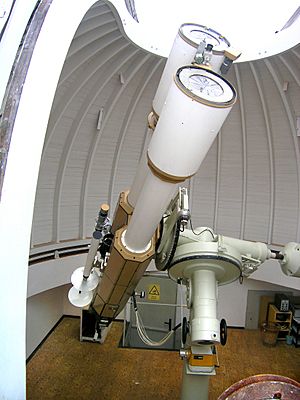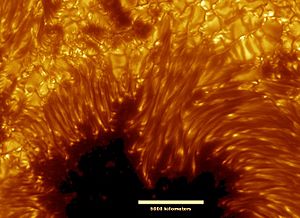Solar telescope facts for kids
A solar telescope is a special telescope designed to safely observe the Sun. Unlike regular telescopes, solar telescopes use special filters to protect your eyes and the telescope itself from the Sun's intense light and heat. These tools help astronomers study different parts of the Sun, like sunspots and solar eclipses. Some solar telescopes even orbit in space, giving us a clearer view without Earth's atmosphere getting in the way.
Contents
Why We Need Solar Telescopes
The Sun is a giant ball of hot gas, and it's incredibly bright and powerful. Looking directly at the Sun, even for a second, can seriously damage your eyes. This is why regular telescopes are not safe for sun-gazing. Solar telescopes are built with special features to block most of the Sun's light, allowing only a tiny, safe amount to reach your eyes or cameras.
How Solar Telescopes Work
Solar telescopes use different methods to make the Sun safe to view. One common way is to use special filters that block most of the light and heat. These filters can be placed at the front of the telescope or inside it.
- White Light Filters: These filters let you see the Sun in "white light," which is how we normally see things. With these, you can observe sunspots, which are darker, cooler areas on the Sun's surface.
- Hydrogen-Alpha (H-alpha) Filters: These are very special filters that only let through a specific color of light called hydrogen-alpha. This light is emitted by hydrogen gas, which is a main part of the Sun. Using H-alpha filters, astronomers can see amazing details like solar flares (huge explosions) and prominences (loops of gas extending from the Sun).
Protecting the Telescope
Because the Sun is so hot, solar telescopes also need ways to handle the heat. Some use special mirrors that reflect most of the heat away, while others might have cooling systems. This keeps the telescope's parts from getting damaged.
What Astronomers Study with Solar Telescopes
Solar telescopes are vital tools for understanding our closest star. Scientists use them to study many different solar phenomena:
- Sunspots: These are temporary dark spots on the Sun's surface. They are cooler than the surrounding areas and are caused by strong magnetic fields. By tracking sunspots, scientists can learn about the Sun's rotation and its magnetic activity.
- Solar Flares: These are sudden, powerful bursts of radiation from the Sun's surface. They can release huge amounts of energy and can sometimes affect Earth's technology, like satellites and power grids.
- Coronal Mass Ejections (CMEs): These are large clouds of plasma and magnetic field that erupt from the Sun's outer atmosphere, called the corona. CMEs can also impact Earth and cause beautiful auroras (northern and southern lights).
- Solar Eclipses: While solar eclipses happen when the Moon blocks the Sun, solar telescopes are used to study the Sun's corona, which becomes visible during a total eclipse.
Space-Based Solar Telescopes
Some solar telescopes are launched into space. These space telescopes have a big advantage: they are above Earth's atmosphere. Our atmosphere blurs images and blocks certain types of light, like X-rays and ultraviolet light. Space telescopes can get much clearer images and observe the Sun in wavelengths of light that can't reach the ground.
- Examples of Space Telescopes: Missions like the Solar Dynamics Observatory (SDO) and the Parker Solar Probe are examples of spacecraft that study the Sun from space, providing incredible data about its activity.
Images for kids
-
The Swedish 1-m Solar Telescope at Roque de los Muchachos Observatory, La Palma in the Canary Islands.
See also
 In Spanish: Telescopio solar para niños
In Spanish: Telescopio solar para niños






